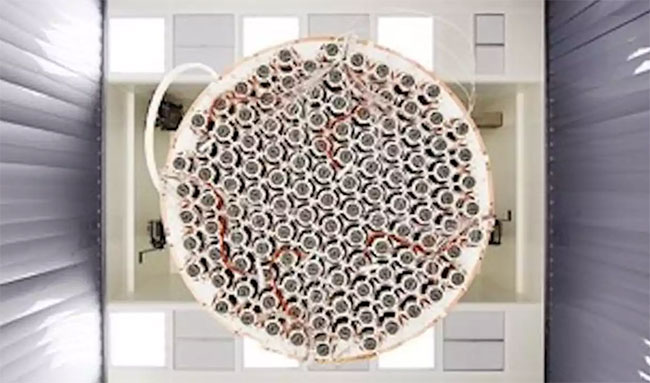Dark matter detector observes foreign nuclear decay
A detector designed to find dark matter, 'lost' mass in the universe, has seen a rare nuclear decay still known as dual-electron capture that liberates two neutrinos (two-neutrino double electron capture ) - with suggestions for nuclear physics and particle physics.
How can you observe a process that takes a billion times longer than the universe? The collaborative team XENON did that with a device designed and manufactured to find dark matter - the universe's most mysterious material. In an article published in Nature , they announced that they have observed radioactive decay of xenon124 , which has a half-life of 1.8 X 1022 years.

XENON1T dark matter detector.(Source: phys.org).
'We have seen the evolution of this decay. This is the longest, most directly observed process, and our dark matter detector is sensitive enough to measure it , 'said Ethan Brown, a physical researcher at Rensselaer and fellow study author said. 'It's amazing to see this process, so we can see that our detector can measure the rarest ever recorded cosmic event.'
The cooperative group XENON operates XENON1T, a tank of 1,300 kilograms of ultra-pure xenon liquid shielded from cosmic rays in a chiller placed below 1,500 meters of water at the foot of Gran Sasso in Italy. Researchers have used it to find dark matter (which is five times more than ordinary matter but rarely interacts with ordinary matter) by noting tiny light rays produced when particles Interaction with xenon inside the detector. And while XENON1T is designed to capture the interaction between a dark matter particle and a nucleus of xenon atoms, the detector often picks up signals from any interaction with xenon.
The evidence of xenon decay is that a proton inside the xenon atomic nucleus is transformed into a neutron. In most elements that follow decay, it occurs when an electron is sucked into the nucleus. But a proton in the xenon atom must absorb two electrons to transform into a neutron, an event still called 'double electron capture '.
Getting dual electrons only happens when two electrons are on the right side of the nucleus at the right time, Brown said, which is 'a rare thing multiplied by another rare thing, it creates super rare things'.
When that super-rare phenomenon occurs, meaning that dual-electron capture occurs inside the detector of dark matter, instant capture devices take signals of electrons in atoms as they rearrange to occupy the two electrons that have been absorbed into the nucleus.
'The electrons in dual capture are removed from the inner shell of the atom around the nucleus, and that creates a gap in the shell itself , ' Brown said. 'The remaining electrons collapse into this ground state, and we see this slowdown process in our detector'.
This is the first time scientists have measured the disintegration of xenon isotopes in a direct observation of its radioactive decay.

Catching electrons and catching dual dual electrons releases two neutrinos.(Source: Nature).
'This fascinating discovery extends the boundaries of understanding the most basic properties of matter,' said Curt Breneman, curator of The School of Science. TS's work. Brown checked the detector and made sure the xenon was refined to meet the highest possible purity standards, thereby contributing significantly to the success of the observation.
The collaboration group XENON Collaboration consists of more than 160 scientists from Europe, the US, the Middle East and since 2002, has operated three ultra-sensitive liquid xenon detectors at the Gran Sasso Italian National Laboratory. XENON1T, the largest of these detectors, was designed and installed, providing a large amount of data from 2016 to 12/2018, when it stopped working. Scientists are currently experimentally upgrading the new phase of XENONnT - a three-times XENON1T mass detector.
- $ 9.2 million detector looking for dark matter failed
- Found signs of dark matter
- Detecting a ring of dark matter
- New explanation of the origin of dark matter
- 11 mysteries about dark matter have not been answered yet
- Revealing the first image of dark matter
- The race to find dark matter is heating up
- Earth is losing dark matter
- The mystery of dark matter has been decoded?
- The first image of the dark matter network, which connects galaxies together
- Detecting dark matter fibers
- Interesting new technology helps explore dark matter
 Van Allen's belt and evidence that the Apollo 11 mission to the Moon was myth
Van Allen's belt and evidence that the Apollo 11 mission to the Moon was myth The levels of civilization in the universe (Kardashev scale)
The levels of civilization in the universe (Kardashev scale) Today Mars, the sun and the Earth are aligned
Today Mars, the sun and the Earth are aligned The Amazon owner announced a secret plan to build a space base for thousands of people
The Amazon owner announced a secret plan to build a space base for thousands of people